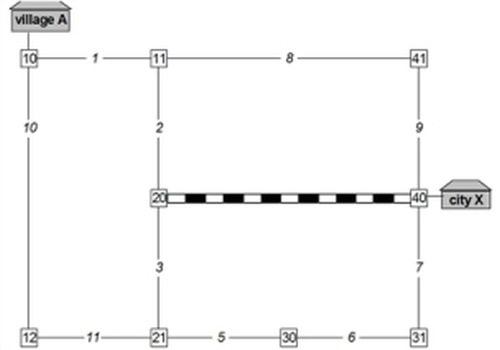The effectiveness of the equilibrium assignment is described in the example in Table 129 and Image 92. The example analyzes the relation between traffic zone "village A" and traffic zone "city X".
- The impedance of the links is determined from the current travel time tCur. The current travel time tCur is in turn calculated using the capacity restraint function BPR with a=1, b=2 and c=1.
- The access and egress times for the connectors are not considered, that is, they are set to 0 minutes.
- Turn penalties are not considered.
With regard to the traffic demand the following applies.
- The traffic demand between A-Village and X-City is 2,000 car trips during peak hour.
- Capacity and demand refer to one hour.
The example network contains three routes which connect village A and city X.
- Route 1 via nodes 10 – 11 – 41 – 40
- Route 2 via nodes 10 – 11 – 20 – 21 – 30 – 31 – 40
- Route 3 via nodes 10 – 12 – 21 – 30 – 31 – 40
Route 1 mainly uses country roads and is 26 km long. It is the shortest route. Route 2 is 30 km long. It is the fastest route because the federal road can be traversed at a speed of 100 km/h if there is free traffic flow.
Route 3 which is also 30 km long is an alternative route which only makes sense if the federal road is congested.

Image 92: Example network for equilibrium assignment
|
LinkNo |
From Node |
To Node |
Type |
Length [m] |
Capacity [car units/h] |
v0-PrT [km/h] |
|
1 |
10 |
11 |
20 Federal road |
5000 |
1200 |
100 |
|
2 |
11 |
20 |
20 Federal road |
5000 |
1200 |
100 |
|
3 |
20 |
21 |
20 Federal road |
5000 |
1200 |
100 |
|
4 |
20 |
40 |
90 Rail track |
10000 |
0 |
0 |
|
5 |
21 |
30 |
20 Federal road |
5000 |
1200 |
100 |
|
6 |
30 |
31 |
20 Federal road |
5000 |
1200 |
100 |
|
7 |
31 |
40 |
20 Federal road |
5000 |
1200 |
100 |
|
8 |
11 |
41 |
30 Country road |
16000 |
800 |
80 |
|
9 |
40 |
41 |
30 Country road |
5000 |
800 |
80 |
|
10 |
10 |
12 |
40 Other roads |
10000 |
500 |
60 |
|
11 |
12 |
21 |
40 Other roads |
5000 |
500 |
60 |
As a result, the assignment provides values of Table 130 for the three routes (PrT paths).
|
Route |
tCur |
Impedance |
Volume (AP) |
|
1 |
46min 39s |
2798 |
1157.488 |
|
2 |
46min 34s |
2794 |
618.079 |
|
3 |
46min 12s |
2772 |
224.432 |
The most important assignment results for links are displayed in Table 131.
|
Link |
tCur |
Impedance |
Volume (AP) |
Saturation PrT (AP) |
VehicleHr(tCur) |
VehKmTravelled PrT |
|
1 |
11min 40s |
700 |
1908 |
170 |
370h 54min 19s |
9537.839 |
|
2 |
5min 47s |
347 |
1157 |
96 |
111h 43min 15s |
5787.442 |
|
3 |
5min 47s |
347 |
1157 |
96 |
111h 43min 15s |
5787.442 |
|
5 |
7min 48s |
468 |
1450 |
126 |
188h 29min 38s |
7249.603 |
|
6 |
7min 48s |
468 |
1450 |
126 |
188h 29min 38s |
7249.603 |
|
7 |
7min 48s |
468 |
1450 |
126 |
188h 29min 38s |
7249.603 |
|
8 |
26min 35s |
1595 |
750 |
110 |
332h 23min 38s |
12001.270 |
|
9 |
8min 19s |
499 |
750 |
110 |
103h 52min 23s |
3750.397 |
|
10 |
15min 12s |
912 |
292 |
72 |
74h 3min 56s |
2924.321 |
|
11 |
7min 36s |
456 |
292 |
72 |
37h 1min 58s |
1462.161 |

